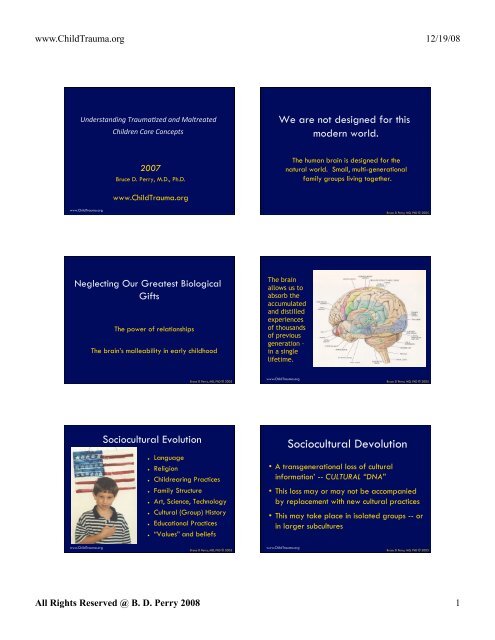Sociocultural Devolution - Mental Health Connection
Sociocultural Devolution - Mental Health Connection
Sociocultural Devolution - Mental Health Connection
- No tags were found...
You also want an ePaper? Increase the reach of your titles
YUMPU automatically turns print PDFs into web optimized ePapers that Google loves.
www.ChildTrauma.org 12/19/08UnderstandingTrauma/zedandMaltreatedChildrenCoreConceptsWe are not designed for thismodern world.2007Bruce D. Perry, M.D., Ph.D.The human brain is designed for thenatural world. Small, multi-generationalfamily groups living together.www.ChildTrauma.orgwww.ChildTrauma.orgBruce D Perry, MD, PhD © 2005Bruce D Perry, MD, PhD © 2005Neglecting Our Greatest BiologicalGiftsThe power of relationshipsThe brain’s malleability in early childhoodThe brainallows us toabsorb theaccumulatedand distilledexperiencesof thousandsof previousgeneration –in a singlelifetime.Bruce D Perry, MD, PhD © 2005www.ChildTrauma.orgBruce D Perry, MD, PhD © 2005<strong>Sociocultural</strong> EvolutionLanguageReligionChildrearing PracticesFamily StructureArt, Science, TechnologyCultural (Group) HistoryEducational Practices“Values” and beliefs<strong>Sociocultural</strong> <strong>Devolution</strong>• A transgenerational loss of culturalinformation’ -- CULTURAL “DNA”• This loss may or may not be accompaniedby replacement with new cultural practices• This may take place in isolated groups -- orin larger subcultureswww.ChildTrauma.orgBruce D Perry, MD, PhD © 2005www.ChildTrauma.orgBruce D Perry, MD, PhD © 2005All Rights Reserved @ B. D. Perry 2008 1
www.ChildTrauma.org 12/19/08The besttime toinfluencethecharacter ofa child is100 yearsbefore theyare born.W.R. IngeAll rights reserved © 2007 BruceD. PerryBruce D Perry, MD, PhD © 2005All rights reserved © 2007 BruceD. PerryBruce D Perry, MD, PhD © 2005Decrease in the Size of “Households”Privacy and IsolationWe live in a child-illiteratesociety.We have lost our efficient mechanisms fortrans-generational passage of child-rearingbeliefs and practices.Bruce D Perry, MD, PhD © 2005www.ChildTrauma.orgBruce D Perry, MD, PhD © 2005The Relational Landscape isChangingChildren have fewer emotional, social andcognitive interactions with fewer people. Theimpact of “modern” life on the developing childhas yet to be fully understood.Poverty of RelationshipsThe compartmentalization of our culturehas resulted in material wealth yet povertyof social and emotional opportunity.Bruce D Perry, MD, PhD © 2005Bruce D Perry, MD, PhD © 2005All Rights Reserved @ B. D. Perry 2008 2
www.ChildTrauma.org 12/19/08So What? Why does this matter?• Human beings are biologically-designed toform and maintain relationships• Relational capabilities determine the globalhealth of a group• Humans are INTERDEPENDENT notINDEPENDENT creaturesWhy does this matter?Why does social and emotionaldevelopment matter?www.ChildTrauma.orgBruce D Perry, MD, PhD © 2005Bruce D Perry, MD, PhD © 2005Why Do We Kill?Murder Rates: Amsterdam1450 vs 1850Murders / 100,000 Peoplewww.ChildTrauma.orgBruce D Perry, MD, PhD © 2005www.ChildTrauma.orgBruce D Perry, MD, PhD © 2005Humans have the potential to beviolent but it is not inevitable. Wealso have the potential forremarkable humanity.There is tremendous variability across culturesand over time in the level of violence in humanliving groups.The hope for First Nations – the vision ofa better world – lies in roots of afragmented culture. <strong>Health</strong> comes fromreweaving culture – not from modernhealthcare.And the hope for the urbanized West – ourvision for healthier communities – can come fromthe lessons – good and bad – learned from theFirst Nations peoples.Bruce D Perry, MD, PhD © 2005Bruce D Perry, MD, PhD © 2005All Rights Reserved @ B. D. Perry 2008 3
www.ChildTrauma.org 12/19/08USE-DEPENDENT DEVELOPMENTThe more a neural system is“activated,” the more that systemchanges to reflect that pattern ofactivationThis is the basis for development, memoryand learningOn Becoming HumaneBeing born a human being does not ensure a child willbecome humane.Humans become humane. The capacity to care, to share, tolisten, value and be empathic – to be compassionate –develops from being cared for, shared with, listened to,valued and nurtured.Humane caregiving expresses our capacity to be humane.Inhumane caregiving can decrease or even destroy thiscapacity.www.ChildTrauma.orgBruce D Perry, MD, PhD © 2005www.ChildTrauma.orgBruce D Perry, MD, PhD © 2005The unit of survival for humanbeings is the clan.The result is a sophisticated and permeatingneurobiology of “social affiliation andcommunication.” The neural systems whichmediate the stress response, reward andcommunicate with the body are interwovenwith the neural systems involved in thisrelational neurobiology.Bruce D Perry, MD, PhD © 2005www.ChildTrauma.orgBruce D Perry, MD, PhD © 2005242418618 6www.ChildTrauma.org12Bruce D Perry, MD, PhD © 2005www.ChildTrauma.org12Bruce D Perry, MD, PhD © 2005All Rights Reserved @ B. D. Perry 2008 4
www.ChildTrauma.org 12/19/08Stimulation of “Reward” Neural Systems in theHuman Brain: Human InteractionsStimulation of “Reward” Neural Systems in theHuman Brain: Decreasing DistressPositiveHumanInteractionMesolimbicDopaminergicand relatedsystemsNADASensation ofpleasure andsafetyRelease ofhormonesand “calmer”regulation ofstressresponseneuralsystemsPositiveHumanInteractionMesolimbicDopaminergicand relatedsystemsNADASensation ofpleasure andsafetyRelease ofhormonesand “calmer”regulation ofstressresponseneuralsystemsBruce D Perry, MD, PhD © 2005DecreasephysiologicaldistressBruce D Perry, MD, PhD © 2005Stimulation of “Reward” Neural Systems inthe Human Brain: Substances of AbuseStimulation of “Reward” Neural Systems inthe Human Brain: FoodDrugs of Abusecocaine, opiates, stimulantsSensation ofpleasure andsafetySweet,salty,fattyfoodsDrugs of Abusecocaine, opiates, stimulantsSensation ofpleasure andsafetyPositiveHumanInteractionNADARelease ofhormonesand “calmer”regulation ofstressresponseneuralsystemsPositiveHumanInteractionNADARelease ofhormonesand “calmer”regulation ofstressresponseneuralsystemsEtOHDecreasephysiologicaldistressEtOHDecreasephysiologicaldistressBruce D Perry, MD, PhD © 2005Bruce D Perry, MD, PhD © 2005The Power of Negative Input24• The human mind pays more attention to negativecomments than to positive• This bias is related to the brain’s primary tasksrelated to survival• In general negative comments are three to fivetimes more “powerful” than positive• Caregiving with low ratio results in more negativecomments due to the need to be reactive andprotective18 6www.ChildTrauma.orgBruce D Perry, MD, PhD © 2005www.ChildTrauma.org12Bruce D Perry, MD, PhD © 2005All Rights Reserved @ B. D. Perry 2008 5
www.ChildTrauma.org 12/19/082418 6Self-defeating Educational,Caregiving, Therapeutic SettingsThe ratio of educator, caregiver, adult to youngchild is far too low to optimize positive andminimize negative!The Greater the Ratio the MoreNecessary Negative Interactions Becomewww.ChildTrauma.org12Bruce D Perry, MD, PhD © 2005Bruce D Perry, MD, PhD © 2005Childhooddecides.Jean Paul SartreNeocortexLimbicDiencephalonBrainstemAbstract thoughtConcrete ThoughtAffiliation"Attachment"Sexual BehaviorEmotional ReactivityMotor Regulation"Arousal"Appetite/SatietySleepBlood PressureHeart RateBody Temperaturewww.ChildTrauma.orgBruce D Perry, MD, PhD © 2005www.ChildTrauma.orgBruce D Perry, MD, PhD © 2005The brain developsand organizes as areflection ofdevelopmentalexperience,organizing inresponse to thepattern, intensityand nature ofsensory andperceptualexperience.Bruce D Perry, MD, PhD © 2005The Brain DevelopsThe human brain, with all of its complexstructure and function, does not just“pop” into existence.In the 9 months following conception, 100 billionneurons and 10 trillion glial cells are born.These cells organize, move, connect andspecialize to create the amazing andfunctioning brain of the newborn.Bruce D Perry, MD, PhD © 2005All Rights Reserved @ B. D. Perry 2008 6
www.ChildTrauma.org 12/19/08First MemoriesIn utero the most dominant repetitive sensoryexperience is the ever-present maternal heart beat.This powerful rhythmic pattern becomes associatedwith warmth, comfort, quiet, satiety and safety.The Primary Initial Rythyms of the Brainstem are 80/bpm and multiples thereof.Development is the sequentialacquisition of memoryThe brain changes from conception to death.The most change in neural systems – i.e., themost creation of “memory” takes place in thefirst years of life.Bruce D Perry, MD, PhD © 2005Bruce D Perry, MD, PhD © 2005Homeostasis and Memory• When incoming sensory signals (sights, sounds, smells,taste) are familiar, the homeostasis of the brain is notaltered.• When an experience has unique patterns of sensorysignal (and corresponding novel neurophysiologicalpatterns) homeostasis is altered - creating and storingnew templates.• Altered homeostasis results in new templates of neuralactivity - memories.The Brain does not like Surprises• All novel stimuli activate “attention”.• Novel stimuli, until proven otherwise, arecategorized as potentially-threatening.• New situations, new faces, new places - evenwhen “fun” - activate a low-level arousal/stress response.www.ChildTrauma.orgBruce D Perry, MD, PhD © 2005www.ChildTrauma.orgBruce D Perry, MD, PhD © 2005From Specific to General• The brain takes associations from a single orspecific event and generalizes to othersituations.• The brain can generalize from the singleabusive father to all adult males.• This process, generalization, can literallyalter the way future experiences are sensed,perceived and processed.Sequential Sensory Processing• All sensory input from the outside world first entersthe brain at level of the brainstem or midbrain.• The process of “matching” against the templates ofprevious neural patterns begins at these levels.• The brainstem, midbrain, and limbic systems maystart “acting” on incoming information even beforethe it reaches the cortex.www.ChildTrauma.orgBruce D Perry, MD, PhD © 2005www.ChildTrauma.orgBruce D Perry, MD, PhD © 2005All Rights Reserved @ B. D. Perry 2008 7
www.ChildTrauma.org 12/19/08SensoryInputPre-corticalassociationOutInwww.ChildTrauma.orgBruce D Perry, MD, PhD © 2005www.ChildTrauma.orgBruce D Perry, MD, PhD © 2005“Out”“In”Multi-levelProcessingUSE-DEPENDENT DEVELOPMENTThe more a neural system is“activated,” the more that systemchanges to reflect that pattern ofactivationThis is the basis for development, memoryand learningwww.ChildTrauma.orgBruce D Perry, MD, PhD © 2005www.ChildTrauma.orgBruce D Perry, MD, PhD © 2005Nature and NurtureThe TransformationPrimary Influence on OrganizationGenetic “Map”EnvironmentandExperiencewww.ChildTrauma.orgTimeBruce D Perry, MD, PhD © 2005www.ChildTrauma.orgBruce D Perry, MD, PhD © 2005All Rights Reserved @ B. D. Perry 2008 8
www.ChildTrauma.org 12/19/08Relative Brain Size: Newbornwww.ChildTrauma.orgBruce D Perry, MD, PhD © 2005www.ChildTrauma.orgBruce D Perry, MD, PhD © 2005Multiples of Weight at Birth2015105Brain Growth vs. Body GrowthBodyBrainToneglect achild is tomurderthem.0 5 10 15 20www.ChildTrauma.orgAge in YearsBruce D Perry, MD, PhD © 2005Daniel DafoeBruce D Perry, MD, PhD © 2005Neglect• Lack of a specific sensory input duringdevelopment results in abnormaldevelopment of the brain.• The abnormal development is in thosebrain systems which sense, perceive,process, “interpret”, and “act on”information related to that specificsensory deprivation.Sensory DeprivationAbsence of sight, sound, touch, taste, smell -andmeaningful combinations ofthese sensationsThe somatosensory bath of early childhood providesthe major sensory cues responsible for organizingkey areas in the brainAbsent these sensory experiences, abnormaldevelopment resultswww.ChildTrauma.orgBruce D Perry, MD, PhD © 2005www.ChildTrauma.orgBruce D Perry, MD, PhD © 2005All Rights Reserved @ B. D. Perry 2008 9
www.ChildTrauma.org 12/19/08EarlyChildhoodNeglectFamily portraitby an 8 year oldboy. Adopted atage 3 from anEasternEuropeanorphanage.3 Year Old Childrenwww.ChildTrauma.orgBruce D Perry, MD, PhD © 2005www.ChildTrauma.orgNormalExtreme NeglectBruce D Perry, MD, PhD © 20053 Year Old Children3 Year Old ChildrenNormalExtreme NeglectNormalExtreme NeglectBruce D Perry, MD, PhD © 2005Bruce D Perry, MD, PhD © 2005www.ChildTrauma.orgBruce D Perry, MD, PhD © 2005www.ChildTrauma.orgBruce D Perry, MD, PhD © 2005All Rights Reserved @ B. D. Perry 2008 10
www.ChildTrauma.org 12/19/08TraumaticEventProlongedAlarmReaction AlteredNeuralSystemsNeocortexLimbicDiencephalonBrainstemAbstract thoughtConcrete ThoughtAffiliation"Attachment"Sexual BehaviorEmotional ReactivityMotor Regulation"Arousal"Appetite/SatietySleepBlood PressureHeart RateBody Temperaturewww.ChildTrauma.orgBruce D Perry, MD, PhD © 2005www.ChildTrauma.orgBruce D Perry, MD, PhD © 2005USE-DEPENDENT DEVELOPMENTThe more a neural system is“activated,” the more that systemchanges to reflect that pattern ofactivationThis is the basis for development, memoryand learningUnpredictableSevereVulnerabilityStressPredictableModerateResiliencewww.ChildTrauma.orgBruce D Perry, MD, PhD © 2005www.ChildTrauma.orgBruce D Perry, MD, PhD © 2005Figure 1. Relationship of ACE score to mean number of comorbidities.*Mean Number ofComorbidities65432100 1 2 3 4 5 6 7-8ACE Score*The mean number of comorbid outcomes in the study sample was 2.1 (range:0-14); means are adjustedfor age, sex, race, and educational attainment. The trend in the means is significant (P
www.ChildTrauma.org 12/19/08CortexGuilt ShameAbstract thoughtConcrete ThoughtResponse to Acute ThreatLimbicMidbrainCerebellumAlcohol –substance abuseAffiliation/reward"Attachment"Sexual BehaviorRelational difficulties Emotional ReactivityDepressive & affectsymptomsMotor Regulation"Arousal"Appetite/SatietySleepTerrorFearAlarmVigilanceDissociationorResilientNormalwithsupportsVulnerablefewsupportsVulnerable “withsupports”BrainstemDANE5-HTTrauma core symptomsBlood PressureHeart RateCalmBody TemperatureTraumatic Eventwww.ChildTrauma.orgBruce D Perry, MD, PhD © 2005www.ChildTrauma.orgBruce D Perry, MD, PhD © 2005Heterogeneous Threat Responses• Hyperarousal• Classic “fight/flight”• Noradrenergic -• locus coeruleus• Increased heart rate• Older children and• males, participatory• trauma• Dissociative• Endogenous opioids• Increased vagal• activity and decreased• heart rate•• Younger children,• females, inescapable• or painful traumaDISSOCIATION• Disengaging from the external”world• Attending to elements of the“inner” worldwww.ChildTrauma.orgBruce D Perry, MD, PhD © 2005www.ChildTrauma.orgBruce D Perry, MD, PhD © 2005Resting Heart Rates: Branch Davidian ChildrenAltered Reactivity From Chronic Threat140130AssaultParentVisitsFireTerror120FearVulnerable110AlarmNormal1009080VigilanceCalmResilient3/8/933/13/933/18/933/23/933/28/934/2/934/7/934/11/934/16/934/21/93BaselineSevere StressTraumawww.ChildTrauma.orgBruce D Perry, MD, PhD © 2005www.ChildTrauma.orgBruce D Perry, MD, PhD © 2005All Rights Reserved @ B. D. Perry 2008 12
www.ChildTrauma.org 12/19/08Fear Changes the Way We ThinkSense ofTimePrimarysecondaryBrain AreasCognition Abstract Concrete Emotional Reactive Reflexive<strong>Mental</strong>StateExtendedFutureNEOCORTEXSubcortexDaysHoursSUBCORTEXLimbicHoursMinutesLIMBICMidbrainCALM ALERT ALARM FEARLoss ofMinutesSense ofSecondsTimeMIDBRAIN BRAINSTEMBrainstem AutonomicTERRORAdaptiveResponseHyperarousalContinuumDissociativeContinuumPrimarysecondaryBrain AreasCognition Abstract Concrete Emotional Reactive Reflex<strong>Mental</strong>StateFear Changes the Way We ActRest(Adult Male)Rest(Male Child)Rest(Female Child)NEOCORTEXSubcortexVigilance Freeze FlightVigilance Resistance Defiance AggressionAvoidance Compliance Dissociation FaintingSUBCORTEXLimbicLIMBICMidbrainMIDBRAINBrainstemCALM ALERT ALARM FEARFightBRAINSTEMAutonomicTERRORwww.ChildTrauma.orgBruce D Perry, MD, PhD © 2005www.ChildTrauma.orgBruce D Perry, MD, PhD © 2005Trauma, Fear and LearningTraumatized children have a set ofproblems in the classroom. These includedifficulties with attending, processing,storing and acting on their experiences inan age-appropriate fashion.HopeAn internalrepresentation of abetter worldBruce D Perry, MD, PhD © 2005Bruce D Perry, MD, PhD © 2005Complex, multi-dimensionalproblems require multidimensional,multi-system solutionsThere is not ONE RIGHT PROGRAM,LAW or POLICY DECISION that willsolve the problems related to youthviolencewww.ChildTrauma.orgBruce D Perry, MD, PhD © 2005Bruce D Perry, MD, PhD © 2005All Rights Reserved @ B. D. Perry 2008 13
www.ChildTrauma.org 12/19/08Any program that decreasesphysical, social and emotionalisolation will be effectivePrenatal care, home visitation, high-quality earlychildcare, parent education, Doula, communityresource centers, school-based service delivery –all can be importantCreating Policy and Practice thatCapitalize on Biological RealitiesDemocracy, public education, suffrage,civil rights – and, ultimately, earlychildhood investmentBruce D Perry, MD, PhD © 2005Bruce D Perry, MD, PhD © 2005Spending on Programs to “Change the Brain”Brain’s Capacity for ChangeChildTrauma Web Sitewww.ChildTrauma.orgwww.ChildTraumaAcademy.com0 3 6 <strong>Mental</strong> <strong>Health</strong> Juvenile Justice 20HeadstartPublic EducationSubstance Abuse Txwww.ChildTrauma.orgAgeBruce D Perry, MD, PhD © 2005Bruce D Perry, MD, PhD © 2005All Rights Reserved @ B. D. Perry 2008 14




